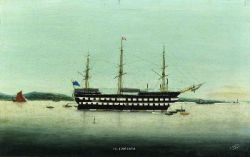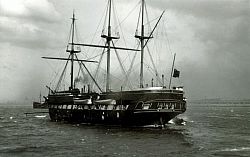This project builds on prior research into children's health and welfare by collecting three new datasets containing information about children's growth.
Training Ships
The first two datasets will be based on the extensive records from two training ships, the Exmouth based in London (1876-1925) and the Indefatigable based in Liverpool (1865-1995).
- The Boys’ Record Books and Admission and Discharge Register of the training ship Exmouth, held at the London Metropolitan Archives, contain 14,000 boys.
- The Cadet Records for the training ship Indefatigable, held at the Maritime Archives and Library (MAL) in Liverpool, contain 10,450 boys.
Both training ships were founded to prepare working class and pauper boys for careers in the Navy or the merchant marine, but unlike the earlier Marine Society data, there do not appear to have been minimum height requirements for boys entering the ships. The boys generally entered the ships at age 10 to 14 and were discharged by the age of 15 to 18. Critically, their height and weight were recorded at entry onto and at discharge from the ship, providing a longitudinal measure of their growth. In addition, the ships’ records were incredibly consistent over the 50-150 year period.


Poor Law Schools
The third historical source that will be transcribed and analysed for the project is the North Surrey School District (NSSD) Records of Children, which contain the heights and weights of approximately 6,100 children who entered the South London poor law school between 1876 and 1897. This dataset is crucial to the project because it contains a wide range of ages, 0-18, covers the period before World War I and includes measurements for boys and girls, allowing a critical gender perspective for the project. It is the only nineteenth century, individual-level dataset extant that would allow children’s growth pattern to be reconstructed from early childhood to adulthood.
Other Sources
In addition to these new records, I will draw upon several existing published and unpublished datasets, which include measurements for girls and a wide range of ages: the records of the Ashford School in London (1908-1916); the Boyd Orr Cohort study (1937-39); Harris’s dataset of incomplete growth profiles for 43 Local Education Authorities; and growth profiles of children collected by medical doctors from the 1860s onwards, which are readily available in medical and human biology publications (Farr et al., 1879; Habakkuk, 1926; and Cameron, 1979). These datasets will complement the training ship and NSSD records by providing snapshots of the growth pattern at various points across the twentieth century.


